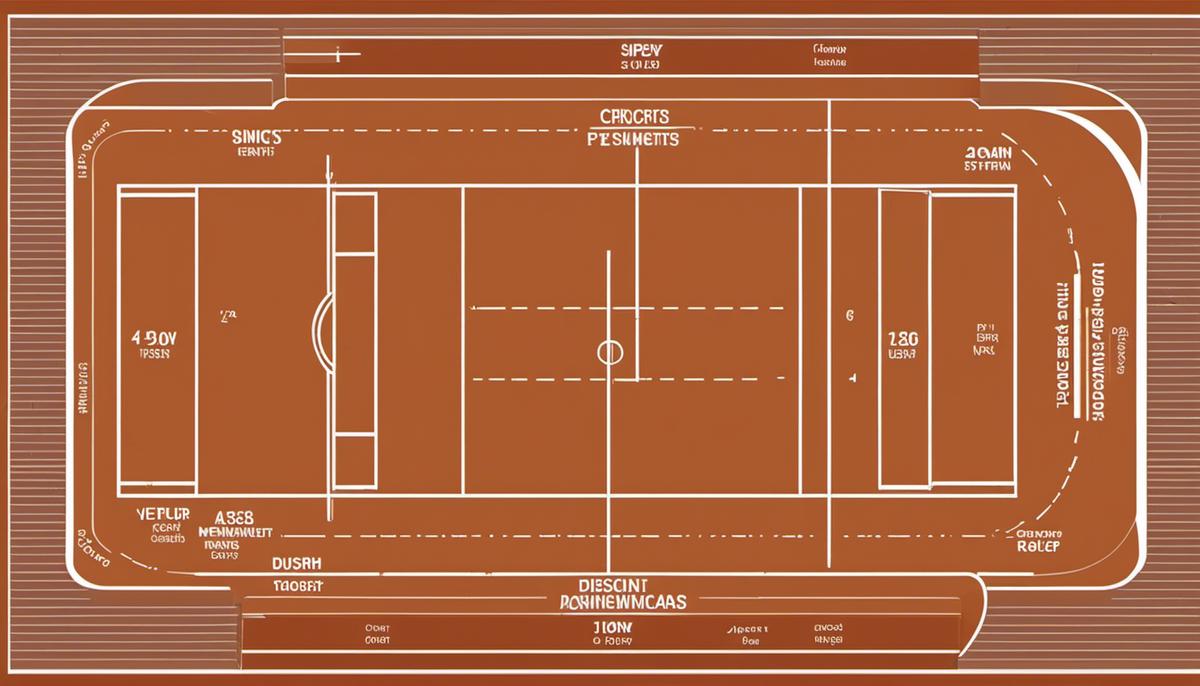In the exhilarating world of sports, the thrill of the games we watch and play is often amplified by the statistics and analytics that serve as crucial determinants. It’s not just about the scores; it’s also about the fascinating intricacies behind the numbers.
Understanding the basics, from distances, time, weight, to scoring systems paves the way to get a hang of sports, whether you’re a seasoned enthusiast or a novice trying to get a grasp. This initiation into the realm of sports measurements not only fosters a deeper appreciation for different games but also sets the stage for uncovering the intriguing complexities buried within each sport.
Understanding the Basics of Measurements in Sports
Embracing Precision: A Deep-Dive into Measurement Units in Sports
There’s a saying in the world of sports, “By inches and seconds, victories are carved.” Nothing could be truer, especially when you begin to appreciate the importance of measurements in defining game outcomes, records, or performances across different sports. Rather than just arbitrary numbers tossed around, these measurement units are fundamental to the fairness, appeal, and thrill of each sport.
Starting with the good ol’ game of football, or should we say, soccer for our American friends. The entire game hinges on dimensions – the playing field should ideally meet the standards set by FIFA which include a length of 100-110 meters (110-120 yards) and a breadth of 64-75 meters (70-80 yards) for international matches. The pros also keep a keen eye on the weight of the football, typically around 14-16 ounces.
Then we have basketball. The orange sphere that gets dribbled, slammed, and tossed into the hoop usually has a diameter of 9.39 inches (23.8 cm). Meanwhile, the hoop itself has an inner diameter of 18 inches (45.7 cm). Even the difference in height of the court — 10 feet (3.05 meters) from the ground — is rigorously measured and maintained.
Venture into the world of American Football, and the first measurement unit that might come to mind is ‘yards’. It makes sense, as a standard field is 120 yards (360 feet /109.7 meters) long. Of course, that includes the 10-yard end zones on both ends. The football itself? It’s approximately 11 inches (28 cm) long and about 22 inches (56 cm) in circumference at its widest point.
Baseball, an American pastime, echoes this focus on measurements with a standard baseball diamond spanning 90 feet (27.4 meters) between each base. The ‘home run’ is a common unit used in evaluations, dependent on the distance between home plate and the outfield fence which varies between ballparks but averages around 400 feet (121.9 meters).
The earth-shattering sport of golf also adheres to measurements. A regulation golf hole diameter is precisely 4.25 inches (10.8 cm), with courses ranging from par-3 to par-5, depending on their length in yards. Unregulated in length, golf courses offer vast spatial variation, making each game an exciting new challenge.
Athletics, swimming and cycling, known for their obsessive focus on time, require meticulous measurements. Here, milliseconds can either create legends or leave athletes off the podium. Distances in track and field range from 100 meters sprints to 42.195 kilometer marathons. Pools are usually 50 or 25 meters long, and cycling races like the iconic Tour de France span jaw-dropping distances in thousands of kilometers!
Ever heard of a ‘stone’? What might seem like a page out of an old English manuscript is actually a weight unit still used in boxing and wrestling, primarily in the UK! Yes, a stone, equivalent to 14 pounds or around 6.35 kilograms, is still in play when we talk about these athletes’ weight categories.
In essence, sports offer a delightful mix of measurement units, each contributing to the unique charm and rigor of the game. Whether longer than a football field or shorter than the diameter of a golf hole, each measurement, each unit, matters. After all, in a world defined by inches and seconds, every detail counts. Without these precision-enforcing norms, the world of sports would be a lot less thrilling, and a lot more chaotic.

Unique Measurements in Specific Sports
Unique Measurements in Different Sports – Peeling Back the Layers
Every sport has a distinctive character, each one a different but harmonious symphony of movement, strategy, timing, and above all, performance. How can we forget about the underlying rhythm that ties these elements together? Measurements. Often, they’re a vital aspect of sports that tend to get overlooked. Unique measurements are the unsung heroes that define how sports are played and give them an extra layer of richness. So, let’s dive deeper and discover how specific sports employ unique measurements.
Starting with tennis, an intriguing game of skill and strategy. The tennis court seems like a simple rectangle of 78 feet by 27 feet for singles and 78 feet by 36 feet for doubles. Yet, the complexities unravel when considering the net height – a solid 3.5 feet at the posts and 3 feet at the center. The measurements here ensure both precision and fairness in an intensely competitive sport.
Next in line, we have ice hockey, a sport pulsating with adrenaline and vigor. The standard rink measures 200 feet by 85 feet – dimensions that carve out the strategic expanse of the game on ice. The puck plays a significant role too, with a standard size of 3 inches in diameter and 1 inch in height. The weight is kept between 5.5 to 6 ounces, enhancing control of the puck and enabling stunning shots.
What about cricket, the gentleman’s sport, beloved worldwide? The unique measurements here add an extra layer of intricacy to the game. A typical pitch measures 22 yards or 20.12 meters long. The distance plays a crucial role in dictating the bowler’s speed, the bounce, and the overall tempo of the game. Cricket balls hold an equal fascination, measuring between 22.4 – 22.9 cm in circumference and weighing between 5.5 – 5.75 ounces.
Remaining in the realm of unique measurements, rugby stands out with its elliptical ball, designed to facilitate easy passing and handling. Typical rugby balls measure around 28.5 cm long and have a circumference of 58 cm lengthwise and 30 cm across the width. The size and shape of the ball are indispensable to the high-energy performance characteristic of this sport.
Heading into the thrilling sphere of motorsports, Formula 1 cars epitomize the convergence of engineering finesse and extreme sport skills. A standard F1 car measures about 15 feet long and 6 feet wide, weighing in at 743 kg, including the driver, tires, and fuel. These specifications enable the remarkable speed and performance of these machines on the circuit.
The world of sports reverberates with the rhythm of unique measurements, binding the diverse arenas with a universal language of precision and performance. These, along with the heart-pounding excitement of the game, constitute the true magic of sports. Digging into the specifics may lead to a newfound appreciation, and who knows, it might even improve one’s approach toward a beloved sport. So go ahead, chase those numbers like an athlete chases victory. There’s so much more beneath the surface in the world of sports waiting to be discovered!

The Role of Measurements in Sports Tactics
Every hobby has its unique specifics, and sports are no different. Whether kicking, throwing, driving or merely showing off physical prowess, the strategic intricacy of each sport can not be overstated. Part of the encompassing strategy hinges on the key understanding and utilization of some distinct measurements. Digging beyond the sports discussed earlier, let’s delve into the importance of these measurements in tennis, ice hockey, cricket, rugby, and Formula 1 Racing.
Starting off on the tennis court, every inch counts, and seeding the winning edge could boil down to knowing the exact measurements and implementing strategic plays accordingly. A standard tennis court measures 78 ft. by 36 ft. The service line is 21 ft. from the net, offering a composed serving player strategic points to exploit. Operating within these lines and exploiting the dimensions could mean the difference between serving an ace or not.
Ice hockey is another sport where the rink plays a vital role. A shrine of ice measuring around 200 ft by 85 ft is a universe complete with goals, lines, and circles – all with different measurements. For example, the distance between the goal line to the blue line adjacent to it, 25 ft, is critical for a strategic play called “the dump and chase” where teams shoot the puck deep into the offensive zone, utilizing the dimensions to their tactical advantage.
In the world of cricket, peppered with tactics and precision, the measurements of the pitch and the ball hold paramount importance. The length of the cricket pitch is approximately 22 yards, a key feature that determines the type of delivery or shot executed by the players. Even the weight and circumference of the cricket ball, generally weighing between 5.5 to 5.75 ounces and measuring between 8 13⁄16 and 9 inches, can affect strategic bowling variations and batting shots.
Switching gears to rugby, a unique-shaped ball itself presents a strategy-formulating challenge. Compared to other ball-based sports, the oval shape and size of a rugby ball, typically around 11-12 inches long and 22-24 inches in circumference, add unpredictability to its movements and require different handling techniques. Each team’s strategy must account for the ball’s unpredictable nature, leading to dynamic and ever-changing tactics.
Now, speeding into the Formula 1 racing lane, the measurements are on a high-stakes, high-speed level. The length, width, height, and weight of these racing machines, falling within 200cm width, 95cm height, and a weight of at least 752 kg (including the driver), greatly influence the speed, maneuverability, and even fuel efficiency. Teams must strategize on how to perfect the car setup to accommodate track length, turns, and weather, ultimately affecting the race outcomes.
With a myriad of sports and hobbies out there, understanding how respective measurements guide the rules, player actions, and strategic planning is more than just a hobbyist fascination. It’s a recognition that every number, from the size of the ball to the boundaries of the arena, plays a decisive role in the thrill and suspense that makes each game memorable and strategic.

Technological Influence on Measurements in Sports

As we approach an era where technology is increasingly becoming symbiotic with sports, we witness a revolution in how we understand and appreciate games. Cutting-edge technologies lend detailed insights into player performance, movement analysis, and in-game measurements. This unprecedented convergence of sports and technology is reshaping the metrics of the field.
This transformative shift promises to blow the lid off traditional stats, reshaping them to offer more in-depth interpretations of the game. It paves the way for an even richer engagement with sports, spinning a promising tale of the future, where the games we love continue to evolve and surprise us, one measurement at a time.
